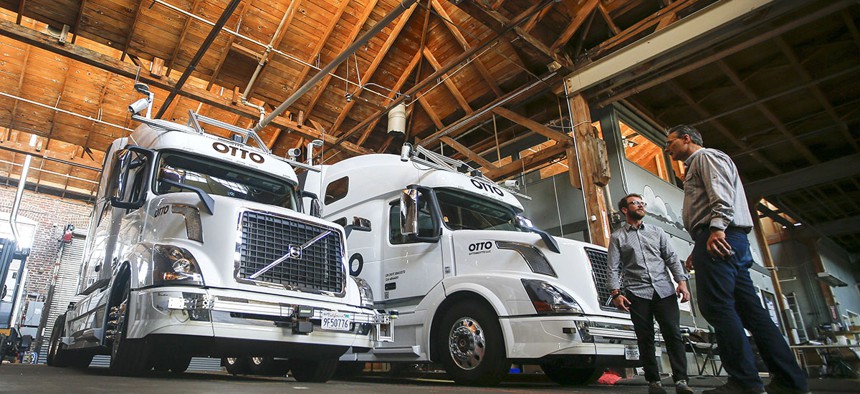Truckers Think Automation Won’t Take Their Jobs for 40 Years. Silicon Valley Strongly Disagrees.

Employees stand next to self-driving, big-rig trucks during a demonstration at the Otto headquarters, in San Francisco. Tony Avelar/AP File Photo
The disconnect about the timing for the arrival of such technology, and the political forces it may unleash, reveals a massive split in how the groups believe the transport industry will evolve.
As far as most truckers can tell, the danger of losing their jobs to robots is still a long, long way off.
“I don’t have a single member who’s ready to buy a bunch of automated trucks even if they could,” says R. J. Cervantes, whose California Trucking Association represents fleet owners in the state. “Everything needs to be sorted out. It’s still in its infancy.” Comments in online trucker forums point out the myriad difficulties of long-distance transport sure to foil computers.
But Silicon Valley sees these as mere speed bumps.
“Three years, at most,” says one venture investor in autonomous vehicle technology, estimating the time before such commercial trucks hit the road, who asked to remain anonyous because of involvement in several companies.
The disconnect about the timing for the arrival of such technology, and the political forces it may unleash, reveals a massive split in how the groups believe the transport industry will evolve. Viewed from one angle, the truckers have a point. There are regulatory hurdles to clear. Social acceptance of autonomous 18-wheelers on highways is not assured. City streets are tough to navigate. Who pumps the gas?
For engineers and investors in the Valley, these seem like speed bumps. Market forces make the rapid deployment of an automated trucking industry almost an inevitability. U.S. truck transport, says freight company Flexport, can double its output for less than half the cost just with partial automation. The technology is nearly ready for highways. Aconvoy of self-driving trucks drove themselves across Europe in April, and the first driverless delivery in the U.S. dropped off 21,000 cases of Budweiser in Colorado Springs, Colorado, this October.
Even more importantly, the assumption that today’s trucking companies will be tomorrow’s is probably wrong. The U.S. trucking industry has few dominant players, and most survive on thin margins, so there is little appetite for splashing out on new technology.
That implies new companies can enter the market, scale quickly and enjoy steep cost advantages—think Uber or Airbnb. Incremental automation will pick off the most profitable (and predictable) routes first, then expand across the country. Over time, it will reduce demand for drivers and drive down wages, and steadily displace existing players. The economics of the $700 billion trucking industry may change irrevocably. Once total automation arrives, the corporate landscape may start to resemble retail, where two players—Walmart and Amazon—dominate.
Roy Bahat, head of the venture capital firm Bloomberg Beta, is worried truckers aren’t preparing for a future coming sooner than they think. He’s held focus groups with truckers as part of the Shift Commission on Work, Workers and Technology to understand how technology will transform the lives of workers and nature of work.
During discussions in Columbus, Ohio, he said, truckers guessed real job losses wouldn’t hit them for another 40 years or more, and wages would stay high.
“They’re not opponents of tech, but it might be a failure of imagination,” he says.
The stakes are high. Investors and researchers disagree on the exact timing, but most agree on one thing: automation will arrive in years, not decades. The technology could ultimately replace 1.7 million American trucking jobs—trucking was the most common job in 28 states in 2014—yet only create a fraction of new positions. The pay for whatever trucking jobs remain may fade from the current average annual wage of $42,500. Next up: 1.7 million taxi, bus and delivery vehicle drivers.
The forces may hit hardest in states where economic populism is already on the rise: there’s strong overlap between the electoral map showing Donald Trump wins in the presidential election, and a map showing states where truck driving is the most common job. As automation erodes middle-class incomes, even as it grows wealth overall, the 2016 election may end up a prelude of the political upheaval to come.


